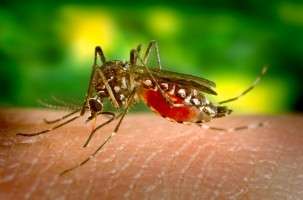Are Zika virus and the climate related?

The World Health Organization on Feb. 1 declared an international public health emergency following outbreaks of Zika virus disease in countries from South America to the United States. Symptoms of the disease are usually mild—fever, rash, joint pain, red eyes—and people infected with it usually don't get sick enough to go to the hospital, according to the federal Centers for Disease Control. Still, the rapid spread of the disease, and its association with a serious birth defect of the brain in infants born to women infected with the disease, have raised the level of concern.
Madeleine Thomson, a scientist at the International Research Institute for Climate and Society, studies the relationship between diseases like Zika, dengue, malaria and others and changes in climate. She spoke at length recently with the Wellcome Trust, a health-focused charity, about the connection. Some excerpts follow. For the full interview, visit the Wellcome Trust blog; you can also read more about the interview at the IRI website.
How are Zika virus and the climate related?
Thomson: We know that virtually all vector-borne diseases have a climate dimension. Temperature drives the rate at which vectors and pathogens [things that cause disease, such as viruses and bacteria] develop, while rainfall often supports the creation of sites for the vectors to breed.
A lot of work has already been done on the relationship between dengue and climate, looking at rainfall and temperature and at how El Niño and La Niña have an impact. The vectors for dengue are Aedes aegypti and Aedes albopictus mosquitoes. This is a starting point for Zika, as it shares the same vectors. A. aegypti is an urban mosquito that breeds in containers where fresh water might collect, from flower vases to water drums to broken coconut shells. It is found only in tropical and subtropical regions. A. albopictus has the potential for a slightly broader geographic range as its eggs can survive long periods in a dormant state.
How easy is it to predict what and where the next big epidemic will be?
Thomson: The recent expansion of the A. aegypti and A. albopictus mosquitoes is very much associated with globalisation – things like the movement of shipping containers around the world, air travel, population movement, forest clearing and urbanization.
We have to expect more of this type of emergence: new diseases that were historically isolated (and therefore didn't have a big impact) which can spread very rapidly and have a huge impact on a large community. Zika is not the last. There'll be others, but predicting exactly what, where and when is really difficult. Instead we need to prepare ourselves to be able to respond rapidly to a broad range of possible threats.
How can climate scientists help the world prepare better for future epidemics?
Thomson: Climate scientists have to be interested in how their science can benefit society in a practical way. Then they have to really look at the time frame of decisions. Climate variability, which includes the impact of El Niño and La Niña, has a significant short-term impact on global temperatures and regional rainfall. Longer-term trends in climate (including those associated with human-induced changes) interact with this variability, meaning that, while likely changes in 50 or 100 years' time are well-understood for some regions, making predictions for the next 5 to 15 years is very difficult. And this is the time frame often requested by decision makers.
People are often asked questions around climate change, but if you are down in the weeds as a malaria, dengue or Zika control person, you are really largely dealing in the time frame of climate variability. What is happening now? What happened last year? What might happen next year in this particular locality?
However, policy makers still need to be aware of what the longer-term trends might be so they can build the institutional capacity needed to respond effectively down the line. You need climate scientists who are able to support decision makers across a range of time and spatial scales.
This story is republished courtesy of the Earth Institute, Columbia University (blogs.ei.columbia.edu/ )
















